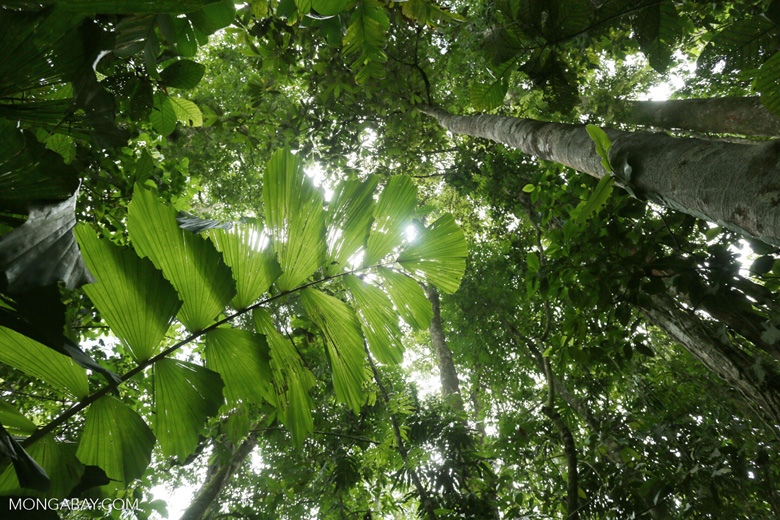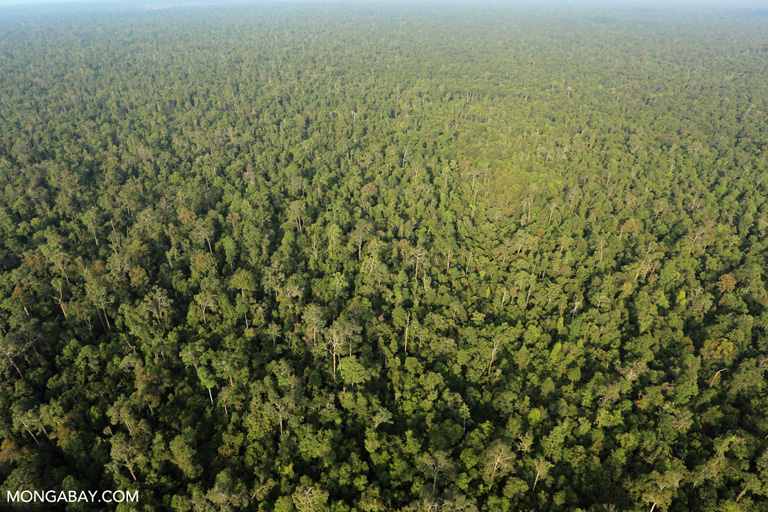- Protecting, restoring, and better managing tropical forests could provide as much as half the net carbon emissions required to meet a 2-degree Celsius climate target.
- The authors cite three opportunities where tropical forests could make substantial contributions: reducing deforestation and degradation, allowing forests degraded by logging and shifting agriculture to recover, and reforesting areas that have been cleared.
- All told, those efforts could sequester and avoid emissions of up to five billion tons per year, or just under half the current level of emissions from fossil fuels, for about 50 years. About 20 percent of that would come via reducing emissions by cutting the amount of trees that are felled and burned, while 80 percent would come from sequestration.
Protecting, restoring, and better managing tropical forests could provide as much as half the net carbon emissions required to meet a 2-degree Celsius climate target, argues a commentary published this week in the journal Nature.
Noting that current rates of fossil fuel burning put the world on a pace to mibss the 2050 target for reducing greenhouse gas pollution, Richard A. Houghton and Alexander Nassikas of Woods Hole Research Center and Brett Byers of Rainforest Trust and the Million Acre Pledge make a case that forests could make a substantial contribution to stabilizing or reducing carbon dioxide emissions in the near term.
“It is unlikely that fossil fuel emissions will fall in the next decade, or that they will fall by more than 80% by 2050. More likely, emissions from fossil fuels from 2015 to 2050 will exceed 250 [billion tons of carbon], resulting in cumulative carbon emissions of over 400 [billion tons of carbon] between 2000 and 2050, and a greater-than-50% chance of exceeding a global warming of 2 °C. So are we already committed to a warming of 2 °C or greater?” the authors write. “Not necessarily — absorption of carbon by tropical forests could offset much of the release of fossil fuel carbon between now and 2050, thus stabilizing and then reducing the CO2 concentration in the atmosphere within just a few decades, and providing a bridge to a fossil-fuel-free world.”

The authors cite three opportunities where tropical forests could make substantial contributions: reducing deforestation and degradation, allowing forests degraded by logging and shifting agriculture to recover, and reforesting areas that have been cleared. All told, those efforts could sequester and avoid emissions of up to five billion tons per year, or just under half the current level of emissions from fossil fuels, for about 50 years. About 20 percent of that would come via reducing emissions by cutting the amount of trees that are felled and burned, while 80 percent would come from sequestration.

The authors also highlight other opportunities in the land use sector, including the same approaches in temperate and boreal forests, agricultural management practices that enhance carbon stocks, and grasslands and wetlands conservation.
The benefits from these practices extend beyond reducing carbon. Protection and restoration of ecosystems will maintain critical environmental services like freshwater availability, support local communities that depend on renewable natural resources, and provide habitat for biodiversity.

Yet despite the potential, there are real risks these carbon sinks may be diminished in the future if current trends continue. For example, climate change is already worsening droughts that cause large-scale die-offs in forests, increasing the vulnerability of forests and other ecosystems to unnatural fires, and triggering disease outbreaks. For that reason, the authors argue that carbon offsets from forest conservation are not the solution to reducing carbon emissions.
“The management of forests to accumulate carbon must not delay or dilute the phasing-out fossil fuel use,” they write. “On the contrary, the deliberate accumulation of carbon on land may be of little long-term benefit if climate change proceeds because of unrestrained use of fossil fuels, and if forests, as a consequence, return to being sources of carbon on a warming and drying Earth.”
Accordingly, the commentary concludes with an urgent call for action.
“The timing and extent of action is critical. Not only should the restoration of the biosphere happen in concert with the phasing out of fossil fuels, but the longer we wait, and the higher the rate of fossil fuel emissions, the smaller the potential role of tropical forests in offsetting those emissions.”

Yet the transition away from ecosystem-destroying approaches to land management won’t be easy, the authors acknowledge. Sectors that drive deforestation, forest degradation, and utilize deforested lands are often politically and economically powerful. In places like Indonesia, the plantation and logging industries have caused large-scale destruction of carbon-dense forests and peatlands, transforming those ecosystems from carbon sinks to carbon sources, while maintaining considerable political clout.
For that reason, a concerted push from a broad alliance of stakeholders is needed to put forests at the front and center of climate change discussions, said co-author Brett Byers, who co-founded the Million Acre Pledge, a conservation initiative, and serves on the board of Rainforest Trust, a conservation group that sets up protected areas in developing countries.
“Tropical forest conservation could provide as much as half of the net carbon dioxide emissions reductions from current levels over the next 50 years,” Byers said. “Tropical forest conservation will be key to the fight against global warming, but it is going to take dramatically increased efforts in the government, charitable and corporate sectors. We’ve protected more than 500 million hectares of tropical forest so far, but the protection of the more than 1 billion remaining hectares is urgent.”

Editor’s note: the original version of this story contained a typo: “About 20 percent of that would come via reducing emissions by cutting the amount of trees that are felled and burned, while 80 percent would come from sequestration.” The first “80 percent” was corrected to “20 percent”.
CITATION: R. A. Houghton, Brett Byers and Alexander A. Nassikas. A role for tropical forests in stabilizing atmospheric CO2. Nature Climate Change 5, 1022–1023 (2015) doi:10.1038/nclimate2869 Published online 25 November 2015
Correction 1/14/2016: The original version of this story included a quote from study author Brett Byers stating that “We’ve protected more than 500 million acre of tropical forest so far, but the protection of the more than 1 billion remaining acres”. The units should have been hectares and has therefore been corrected.
